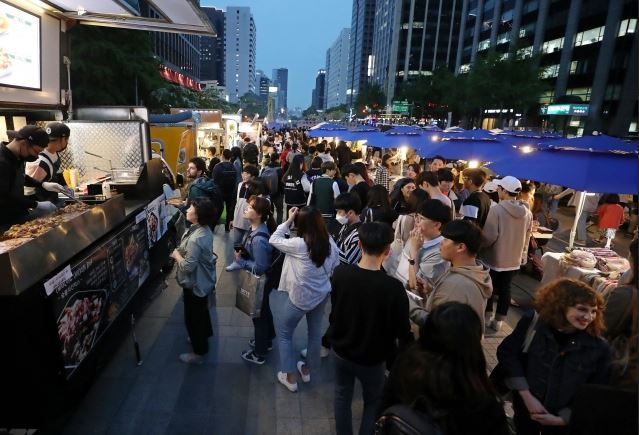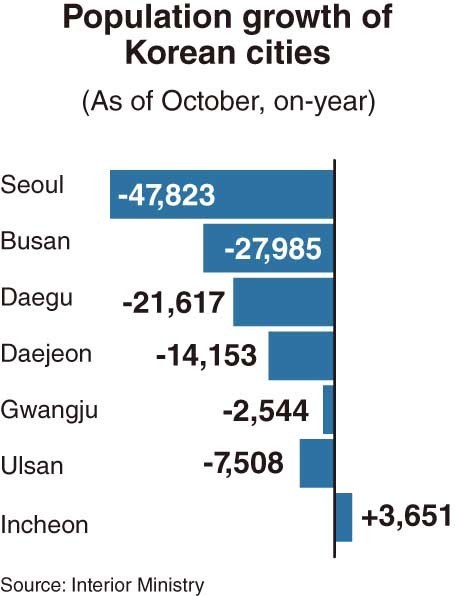[News Focus] Population of 7 major cities falls 117,000 in a year
By Kim Yon-sePublished : Nov. 3, 2019 - 18:06
SEJONG -- South Korea’s major cities are undergoing a demographic change, an apparent shift from the steady expansion they saw between the 1960s and the early 2000s.
Statistics showed that the combined population of seven major cities, including Seoul, has continued to fall in recent years and months. This net decline in the number of residents may be due to the outflow of people to new residential towns.
According to the Ministry of Interior and Safety, the total population came to 51.85 million as of October, up 1,452 from a month earlier.
In contrast, the seven major cities -- Seoul, Busan, Daegu, Daejeon, Ulsan, Gwangju and Incheon -- reported a drop of 10,243 in the month from September to October. Of these cities only Incheon saw a slight gain in population, but not enough to offset the overall trend.
This trend was strongest in Seoul, with 4,109 fewer residents for a total population of 9.73 million. It was next most prominent in Busan, with 2,631 fewer residents and a total population of 3.41 million. Daegu lost 1,742 residents to record 2.44 million, Daejeon lost 1,205 and posted 1.47 million, and Ulsan lost 464 and posted 1.14 million. Gwangju posted a population of 1.45 million, a decline of 272. In contrast, Incheon saw its population inch up 180 to 2.95 million.
Statistics showed that the combined population of seven major cities, including Seoul, has continued to fall in recent years and months. This net decline in the number of residents may be due to the outflow of people to new residential towns.
According to the Ministry of Interior and Safety, the total population came to 51.85 million as of October, up 1,452 from a month earlier.
In contrast, the seven major cities -- Seoul, Busan, Daegu, Daejeon, Ulsan, Gwangju and Incheon -- reported a drop of 10,243 in the month from September to October. Of these cities only Incheon saw a slight gain in population, but not enough to offset the overall trend.
This trend was strongest in Seoul, with 4,109 fewer residents for a total population of 9.73 million. It was next most prominent in Busan, with 2,631 fewer residents and a total population of 3.41 million. Daegu lost 1,742 residents to record 2.44 million, Daejeon lost 1,205 and posted 1.47 million, and Ulsan lost 464 and posted 1.14 million. Gwangju posted a population of 1.45 million, a decline of 272. In contrast, Incheon saw its population inch up 180 to 2.95 million.

On an on-year basis, compared with October 2018, the seven cities saw their collective population decrease by 117,979. The two largest cities, Seoul and Busan, posted respective declines of 47,823 and 27,985.
The trend is largely attributable to the movement of Seoul citizens en masse to new residential towns in Gyeonggi Province and to the rapid expansion of Sejong City, which has actively absorbed residents from Daejeon, Seoul and other cities since 2012.
Over the past year, from October 2018 to October 2019, Gyeonggi Province saw its population increase by 173,689 (1.3 percent) to 13.2 million, and Sejong by 25,953 (8.3 percent) to 336,356.
One demographer said, “The continuous population drop in the big cities is signaling the upcoming era of a decrease in total population, irrespective of relocation of their residences.”
Furthermore, five of the country’s nine provinces saw their resident numbers drop over the corresponding period (October 2018 to October 2019), he added.
North Jeolla Province’s population shrank by 17,545 to 1.82 million, and South Jeolla Province saw the next-steepest decline with 16,381 fewer residents for a total population of 1.86 million. South Gyeongsang Province lost 11,474 residents to record 3.36 million. North Gyeongsang and Gangwon provinces saw their populations fall by 10,832 and 2,544, respectively.
Conversely, Gyeonggi, South Chungcheong, North Chungcheong and Jeju provinces posted on-year population increases.
Data from Statistics Korea suggest that the country’s total population will start falling in 2029 after peaking at 51.94 million in 2028, while some demographers forecast an earlier population decline, citing the downward slide in the nation’s marriage rate since 2011.

According to Statistics Korea, the nation’s population will fall below 50 million in 2044 (49.87 million), below 45 million in 2056 (44.89 million) and below 40 million in 2066 (39.79 million).
Over the past five years, the population of Korea increased only 1.06 percent -- from 51.3 million in October 2014 to 51.85 million in October 2019.
According to the Interior Ministry, the number of Koreans increased only 548,661 over that same five-year period. This indicates growth of less than 9,200 a month on average.
In addition to the number of children under 15, which has seen a steep decline in recent years, so has the working-age population, defined as those between the ages of 15 and 64.
In contrast, the number of people aged 70 or over is posting sharp growth.
The number of Koreans aged 70-79 came to 3.58 million as of last month, followed by those in the 80-89 age bracket at 1.61 million, those aged 90-99 at 228,000 and centenarians at 19,984.
Meanwhile, the number of men in the nation fell for the third consecutive month -- having declined by 261 in August, 354 in September and 844 in October -- while the number of women increased by more than 2,000 a month during the same time frame.
By Kim Yon-se (kys@heraldcorp.com)


![[Herald Interview] 'Amid aging population, Korea to invite more young professionals from overseas'](http://res.heraldm.com/phpwas/restmb_idxmake.php?idx=644&simg=/content/image/2024/04/24/20240424050844_0.jpg&u=20240424200058)















